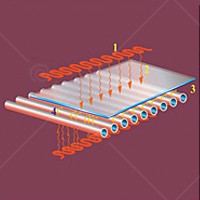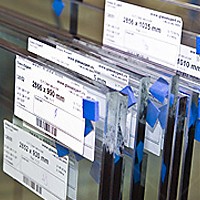Glass Tempering Process
The cooling and heating curve parameters are electronically controlled
Tempered or hardened glass is produced by heating the glass to a temperature of about 650 degrees Celsius, where it begins to soften. The external surfaces are then rapidly cooled, creating a strong compression effect. This heating-cooling process is electronically controlled and the specific parameters applied influence the final quality of the tempered glass.
Production quality monitoring software
QMS – Quality Management System. With the help of the system’s tempering management system, we can track and analyse the relevant parameters and curves, ensuring quality is monitored at all times. In this way we can be certain that the standards applicable to this type of product are upheld.
Full Process Monitoring Software – GTMP
GTMP – Glass Tempered Management Process. Because we are interested in not only the quality of the glass, but also what happens throughout the production process (order, delivery and especially after delivery), we have implemented a security management system that offers a multitude of benefits for our customers. The processing of orders is done electronically, with each glass piece being labelled. A single barcode applied to each panel enables effortless tracking of the glass through the entire process, from cutting, machining, drilling, to tempering and finishing and onward. The information contained in the barcode includes data about the glass type, panel dimensions, type of processing, customer name and a unique code for each panel within in a specific project.
The glass tempering process is done in accordance with the EN 12150 and EN 1863 European standards
Because we understand the importance of the quality of the tempered glass, we work hard to ensure our products are in line with European regulations. The quality of our glass tempering not only meets the required standards, but exceeds them; the flatness deviations in our products are significantly lower than those indicated as acceptable in the EU regulations.
Due to the fact that we use special Low-E SOFT glass cleaning brushes, and that the glass is handled using special gloves (for Reflective or Low-E glass), scratches are virtually eliminated.
We understand that tempered glass is primarily a safety glass and we therefore responsibly account for and regularly test all glass we produce according to EU standards. The production control system includes procedures, regular inspections and tests, as described in the EN 12150 and EN 1863 standards, as well as in the quality manual including the ISO 9001 certification by the ‘QS Cert’ certification body.
Heat Soak Test – a destructive test used to minimise the risk of spontaneous tempered glass breakage
In order to reduce the risk of spontaneous breakage due to the presence of Nickel Sulphide (NiS) inclusions in the tempered safety glass, the glass is subjected to an additional thermal treatment called a “Heat-Soak Test”. This test is regulated by the EN 14179 European standard and consists of heating and then cooling the glass according to certain temperature curves. Being destructive, this treatment eliminates most of the glass that is at risk but cannot, under the current technical conditions, eliminate 100% of the effected material. The risk of spontaneous breakage is, however, considerably reduced. This treatment is advised in all cases in which stability of work, maintaining closure or coverage volume and/or the safety of users may be endangered by a tempered glass breakage
TAMGLASS Pro-E 2442 tempering line specifications
Maximum size of tempered glass: 2400 mm x 4400 mm
We have the ability to temper glass between 4mm and 19mm thick.
We temper any type of glass, clear float, ultra-clear, coloured, ornamental, reflexive, Low-E Hard and SOFT with emissivities up to 0.02.
Minimum size: 250 mm x 200 mm.
Working capacity: 220 m² / h for clear 4 mm glass and 50 m² / h for 19 mm thick glass.








